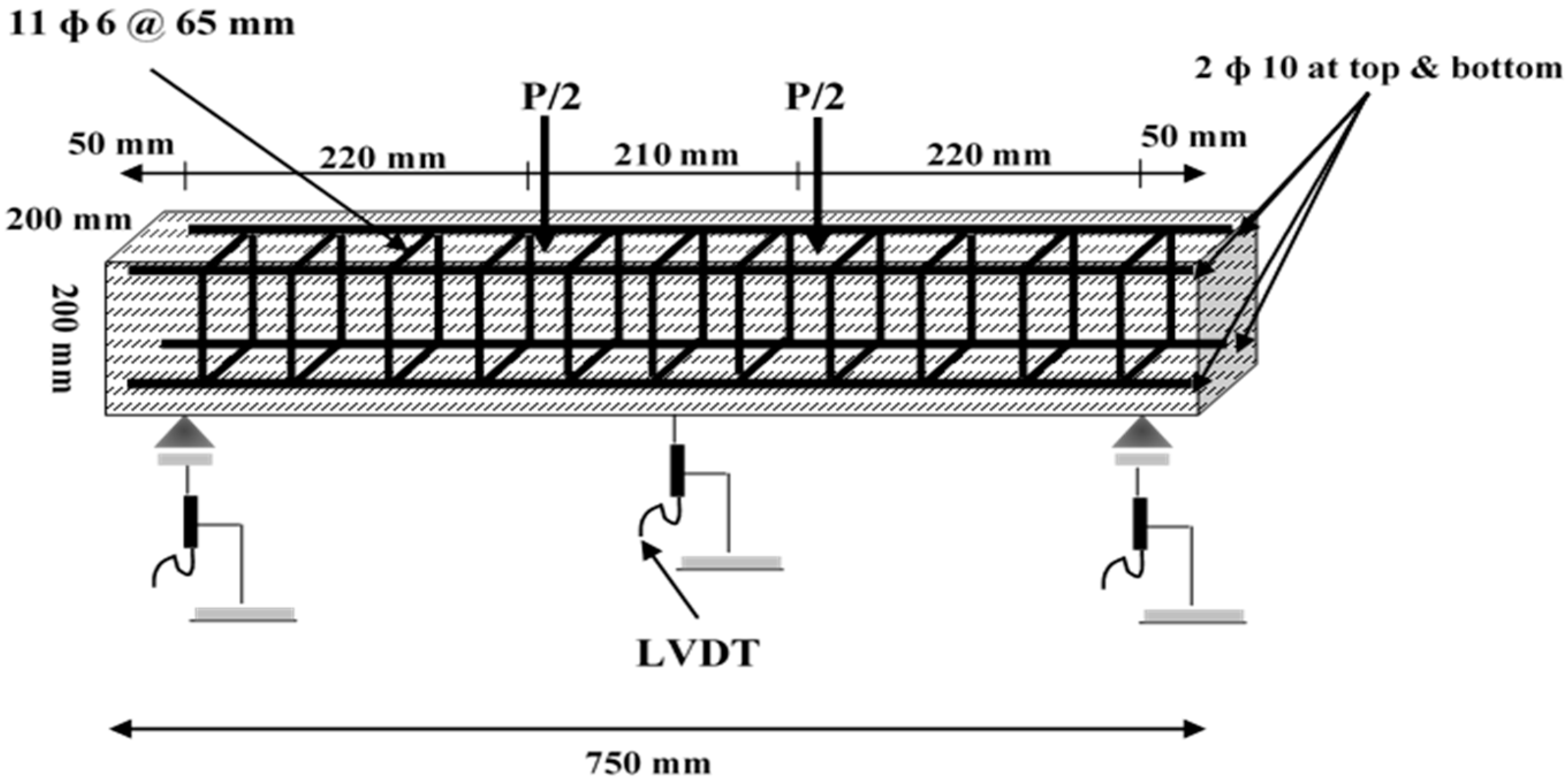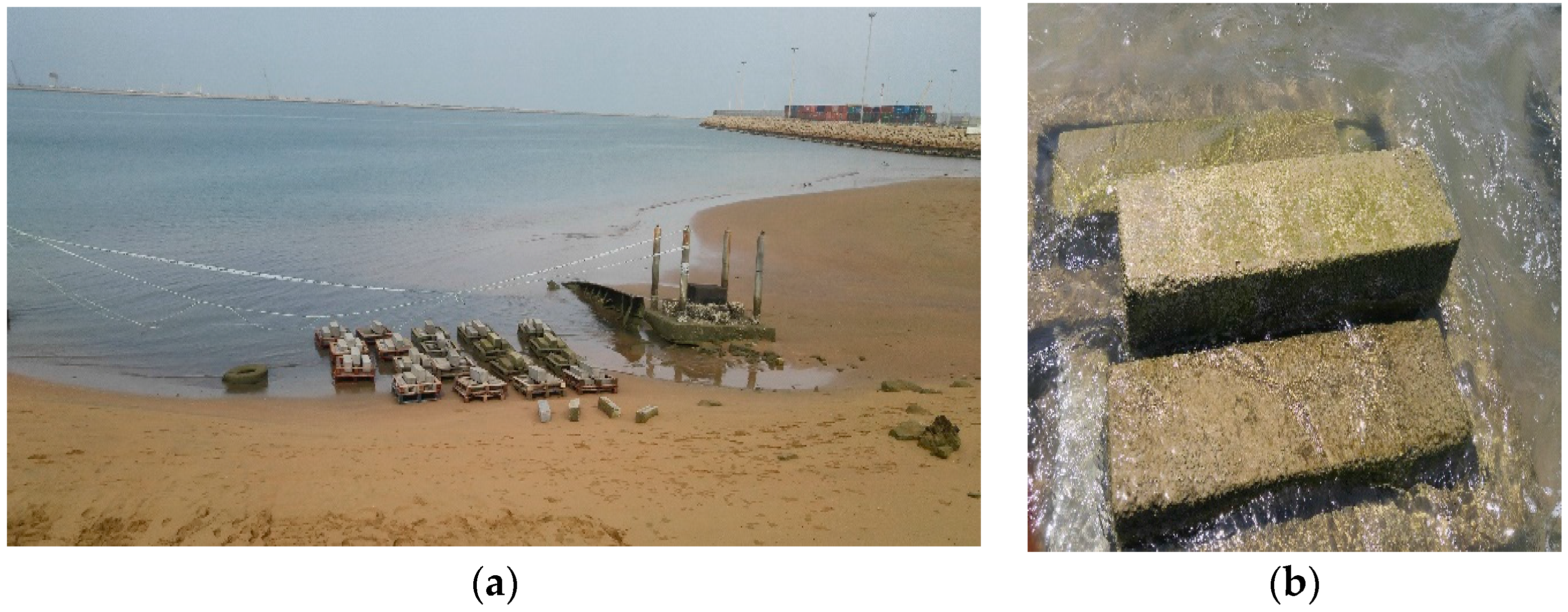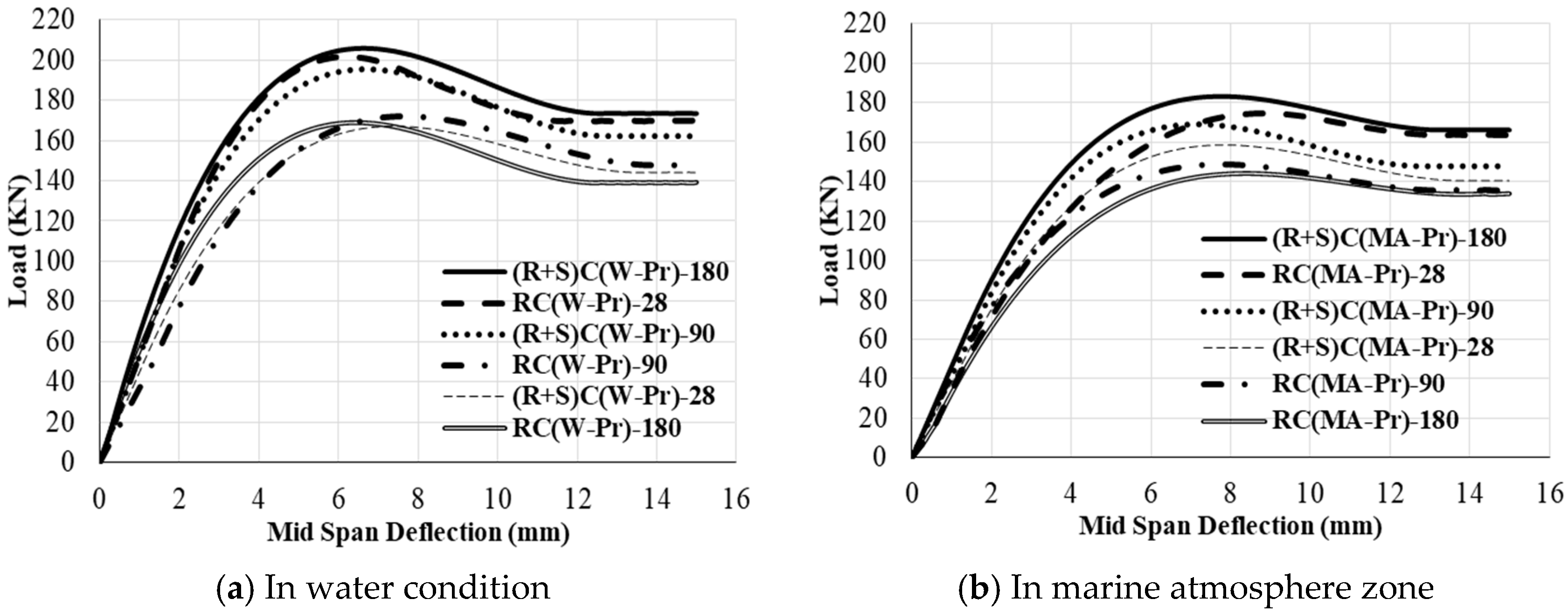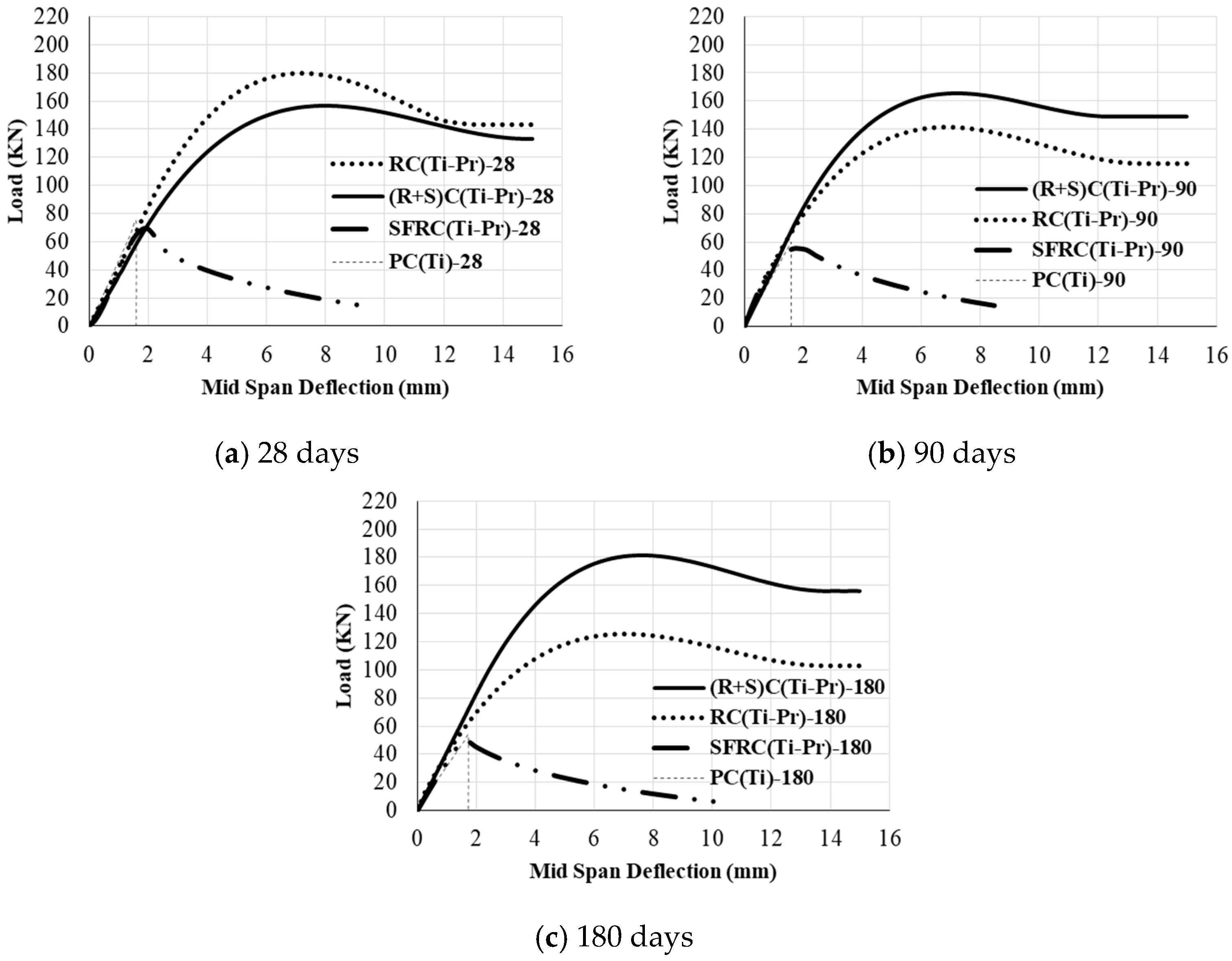Considering the achieved load-deflection diagram (
Figure 4,
Figure 5 and
Figure 6), the calculated parameters were
Pmax,
fr,
T, and
S.S of PC, SFRC, RC, and (R+S)C beams in marine atmosphere, tidal zone, and fresh water (according to
Table 4 and
Table 5). In term of
fr,
T and
S.S definitions:
As can be known,
fr as a flexural strength is calculated from
Pmax (Equation (1)) [
22]:
where
L is span length (650 mm),
b is the average width (200 mm), and
h is the average depth of the beam (200 mm). The
T is a measure of the energy absorption capacity of the beam, which is calculated by the area of the load-deflection diagram up to a specific point, such as maximum deflection [
23]. A comparison of the
T cannot be easily carried out for beams with fiber and bar, as it is quite difficult to identify a maximum deflection. However, in this study for calculating the
T, maximum deflection was selected 15 mm for all of the beams.
S.S values were determined as the slope of the load-deflection diagram following the initiation of flexural cracking, and were obtained by calculating the line slope between the two points corresponding to 50% and 80% of the
Pmax on the ascending branch of the load–deflection diagram [
20].
After the determination of result data and plot of diagrams for each mixture series, the trend of diagrams was determined and drawn. Scatter of the diagrams was generally related to small changes in temperature and the humidity condition at the time of making the concrete and error in the sensitivity of machine sensors in the record of the diagram. The average flexural load–deflection diagram was shown in
Figure 4,
Figure 5 and
Figure 6. In following sections, by measured values from Load-Deflections diagram effect of steel fibers on
Pmax,
fr,
T and
S.S of PC and RC beams (un-cracked and pre-cracked) in marine atmosphere, tidal zone, and fresh water will be studied.
3.1. Flexural Strength and Toughness of Pre-Cracked (R+S)C Beams in Water and Marine Atmosphere Condition
Figure 4 shows the load-vertical deflection diagrams for pre-cracked RC and (R+S)C beams at 28, 90 and 180 days in fresh water and marine atmosphere condition.
In the water conditions,
Pmax(Pr-RC)28 and
T(Pr-RC)28 by addition of steel fibers were decreased about 16%. However,
Pmax(Pr-(R+S)C)180 and
T(Pr-(R+S)C)180 were 22% higher than
Pmax(Pr-RC)180 and
T(Pr-RC)180. Consequently, with an increasing of age, the role of steel fiber in arresting the cracks will be significant. In water condition, up to 180 days, the effect of steel fiber on increment of
T(Pr-RC) and
Pmax(Pr-RC) was approximately the same. By the addition of steel fiber to the pre-cracked RC beam in water environment, the
S.S(Pr-RC)28 was decreased by about 37%. However, at 180 days, the
S.S(Pr-(R+S)C)180 was 38% higher than
S.S(Pr-RC)180. Because of the cracking limitation, as well as delay in the growing of cracks, the role of steel fiber in
S.S(Pr-RC) at 180 days will be increased. The main reason for decreasing the
T(Pr-RC) and
Pmax(Pr-RC) by addition of steel fiber at 28 days may be related to a higher porosity in concrete in primary ages. Increasing
T(Pr-RC) and
Pmax(Pr-RC) at 180 days in water environment may be due to the effect of steel fibers in increasing the bar-to-concrete bond and bridging faces of cracks [
19,
24]. Generally, the use of steel fibers in concrete can be efficient in the limitation of cracks at both micro and macro dimensions. At the micro-level, steel fibers prevent the beginning and development of cracks, and after the micro-cracks link with together and change to macro-cracks, steel fibers prepare mechanisms that provide effective bridging and reduce the rate of crack growth, finally enhancing the toughness and ductility [
3,
4].
By addition of steel fiber to pre-cracked RC beams in the marine atmosphere environment, the
Pmax(Pr-RC)28 and
T(Pr-RC)28 were decreased 9% and 7%, respectively. With increasing the age,
Pmax(Pr-(R+S)C)180 and
T(Pr-(R+S)C)180 were approximately 27% higher than
Pmax(Pr-RC)180 and
T(Pr-RC)180. Thus, in marine atmosphere environment like to water condition, the steel fiber role in limitation of crack width at 180 days was bolded. According to the
Figure 4, at 28 days, the amount of
Pmax(Pr-(R+S)C)28 and
T(Pr-(R+S)C)28 in the water and marine atmosphere condition did not have noticeable differences, while at 180 days, the role of marine atmosphere environment in decrease of
Pmax(Pr-(R+S)C)28 and
T(Pr-(R+S)C)28 will be bolded. In a marine atmosphere environment of up to 180 days, the effect of steel fiber on the growth of
Pmax(Pr-RC) and
T(Pr-RC) was approximately the same. By addition of steel fiber to the pre-cracked RC beam, the
S.S(Pr-RC)28 was decreased by about 6%. However, at 180 days, the
S.S(Pr-(R+S)C)180 was 43% higher than
S.S(Pr-RC)180.
The reason for the decrease of
Pmax(Pr-RC) and
T(Pr-RC) at 28 days by the addition of steel fibers in the marine atmosphere region may be due to an increase in the concrete porosity by steel fiber and a lack of concrete self-healing in early ages. Moreover, a serious deficiency may exist in the transition zone of FRC. Especially in the earlier ages, there is a thick and weak transition zone with a lot of porosity between steel fibers and the paste, which can lead to a decrease in the flexural capacity [
25].
However, with increasing the age, decreasing the porosity, and consolidating the transition zone, the role of steel fibers on the enhancement of
Pmax(Pr-RC) and
T(Pr-RC) will be increased. Moreover, the appearance of light corrosion at the surface of the steel fibers leads to an enhancement of their bond and further friction with the cementitious matrix, and finally,
Pmax(Pr-RC) and
T(Pr-RC) will be increased. Since the formation of cracks in concrete was delayed by the addition of steel fiber [
26], an increment of
S.S by the addition of steel fiber to the pre-cracked RC beams would be justified. According to
Figure 4, at the beginning of the diagram, the slope of diagram for pre-cracked (R+S)C beams was higher than pre-cracked RC beams. It may be due to the increase of rigidity by steel fibers by arresting the cracks and reducing the deflection.
3.2. Flexural Strength and Toughness of Un-Cracked Beams in Marine Tidal Zone
Figure 5 shows the load-vertical deflection diagrams for un-cracked beams in tidal zone at 28, 90 and 180 days.
In tidal zone, by the addition of steel fibers to the PC beams, Pmax(PC)28 and T(PC)28 was increased 46% and 586%, respectively. It was cleared that the role of steel fibers in increasing the T(PC) is higher than the Pmax(PC). The slope of PC and SFRC diagram at the beginning was approximately the same. It can be due to the more important role of steel fiber after cracking rather than before concrete cracking. By addition of steel fibers to the un-cracked RC beams in the tidal zone environment, the Pmax(Un-RC)28 and T(Un-RC)28 were increased 14% and 12%, respectively. It was cleared that the slope of un-cracked (R+S)C and un-cracked RC diagrams is approximately the same. Moreover, by addition of steel fiber to the un-cracked RC beams, the S.S(Un-RC)28 is increased by about 27%. In the tidal zone at 90 days, Pmax(Un-SFRC)90 was 34% higher than Pmax(PC)90. T(Un-SFRC)90 was also 516% higher than T(PC)90. Meanwhile, Pmax(Un-(R+S)C)90 and T(Un-(R+S)C)90, were about 14% higher than Pmax(Un-RC)90 and T(Un-RC)28. Moreover, S.S(Un-(R+S)C)90 was 35% higher than S.S(Un-RC)90.
At 180 days, by addition of steel fibers to the PC beams, Pmax(PC)180 was increased 24% while the T(PC)180 was increased 514%. It was cleared that the main role of steel fibers in increasing the T(PC) is higher than the Pmax(PC). The slope of PC and SFRC diagram at the beginning was approximately the same. It may be due to the more important role of steel fiber after cracking, rather than before concrete cracking. At 180 days, in tidal zone environment, the Pmax(Un-RC)180 and T(Un-RC)180 was increased by about 19%. Thus, the positive role of steel fibers in increasing the Pmax(Un-RC) and T(Un-RC) was approximately the same. It was cleared that the slope of diagram related to un-cracked (R+S)C and RC beams, is approximately equaled. Moreover, By the addition of steel fiber to the un-cracked RC beams, the S.S(Un-RC)180 was increased by about 16%.
Steel fibers could increase the rigidity by arresting the crack and reducing the crack growth. Generally, in SFRC, The corrosion may act in different manners, with the following different effects: [
11] (a) if the fibers strength is reduced noticeably by the corrosion,
Pmax will be decreased, with an embrittlement behavior after
Pmax; (b) if the crack self-healing happens during marine condition,
Pmax will be increased due to concrete continuity through the crack. Moreover, the post-peak behavior is expected to rejoin one of the non-corroded beams; and, (c) if the crack healing does not happen, corrosion of the fibers lead to an increase in their friction in the cement matrix. According to mechanisms (a) to (c), the reason for increasing the
Pmax and
T may be due to the corrosion of steel fibers surface and concrete self-healing.
Because of the following reason, the corrosion of steel fibers up to 180 days cannot lead to a decrease of
Pmax: (1) the expansive forces from corrosion of steel fibers are not enough for the concrete detachment because of the little diameter of fibers and the little volume created by the oxides. Consequently, the corrosive process is not sufficient to split the concrete [
27]; (2) if the crack width is thinner than about 0.1 mm than the steel fiber will not corrode. If the cracks width is ranged between 0.1 mm to 0.5 mm, a little corrosion of the steel fibers with no decrease of their section happens. Only in steel fibers crossing the crack within a 2–3 mm rim from the external faces of the beams, the wide corrosion is observed [
11]. According to the reasons (1) and (2), corrosion of steel fiber and the loss of its strength is difficult. However, maybe the formation of light corrosion on the surface of steel fiber leads to an increase of the friction in the cement matrix-fiber interface and growth of
Pmax and
T.
3.3. Flexural Strength and Toughness of Pre-Cracked Beams in Marine Tidal Zone
Figure 6 shows the load-vertical deflection diagrams for pre-cracked SFRC, RC, (R+S)C, and PC beams in the tidal zone at 28, 90 and 180 days.
It was found that the Pmax(PC)28 is approximately 6% higher than Pmax(Pr-SFRC)28 in the tidal zone. However, the T(Pr-SFRC)28 was 441% higher than T(PC)28. It may be related to the more important role of steel fiber in T rather than the Pmax. By addition of steel fiber to pre-cracked RC beams, the Pmax(Pr-RC)28 and T(Pr-RC)28 were decreased 13% and 11%, respectively. It may be due to a higher porosity of concrete in pre-cracked (R+S)C beams rather than pre-cracked RC beams at 28 days. The effect of steel fiber on the decrease of Pmax(Pr-RC)28 and T(Pr-RC)28, was approximately the same. Moreover, by the addition of steel fiber to the pre-cracked RC beams, S.S(Pr-RC)28 was decreased by about 11%. Pmax(Pr-SFRC)90 was 8% lower than Pmax(PC)90, T(Pr-SFRC)90 was 482% higher than T(PC)90. Pmax(Pr-(R+S)C)90, and T(Pr-(R+S)C)90, were about 17% higher than Pmax(Pr-RC)90 and T(Pr-RC)90. The S.S(Pr-(R+S)C)90 is 16% more than S.S(Pr-RC)90.
At 180 days, it was cleared that the
Pmax(PC)180 is approximately 7% higher than
Pmax(Pr-SFRC)180 in the tidal environment. However, the
T(Pr-SFRC)180 was 387% higher than
T(PC)180. It may be due to the bolded role of steel fiber in
T rather than
Pmax. By addition of steel fiber to pre-cracked RC beams,
Pmax(Pr-RC)180 and
T(Pr-RC)180 were increased by about 43%. Reduction of steel bar corrosion in pre-cracked (R+S)C beams and an increase of
Pmax(Pr-R)C and
T(Pr-R)C,
(Pr-RC) may be due to three reasons: (1) the cracks width in (R+S)C beams is lower than the RC beams due to the bridging of cracks by the steel fibers and the higher fracture resistance of (R+S)C beams; (2) based on observation analysis, the formation of self-healing products in some of the cracks in the SFRC beam is considerable; and, (3) anodic and cathodic region are formed in steel bars when the corrosion of the steel bar will happen in pre-cracked RC beams. In the case of (R+S)C beams, steel fibers are distributed randomly. Consequently, it is possible to touch the steel bar and fiber and interconnect in the cover zone. Due to their connectivity, the anodic region is extended from the steel bar to steel fibers. Hence, the steel fibers play the role of the sacrificial anodic zone and the corrosion in the cathodic region continues until the availability of hydroxyl ions. Thus, steel fiber will be corroded before the steel bar and the corrosion of steel bar will be reduced or stopped. The rest of the steel fibers that is disconnected to the steel bar will be preserved by the concrete alkalinity [
13]. Therefore, in pre-cracked (R+S)C beams, bonding between bar and cement past will be higher than the pre-cracked RC beams. Consequently,
Pmax(Pr-(R+S)C) and
T(Pr-(R+S)C) will be higher than
Pmax(Pr-RC) and
T(Pr-RC).
It was indicated that by addition of steel fiber to the pre-cracked RC beams,
S.S(Pr-RC)180 is increased by 42%. It may be because of the steel fiber role in the limitation of cracking and reducing the growth of cracks, as well as the decreasing of porosity in higher ages. At the beginning of the diagram, the slope of diagram for pre-cracked (R+S)C beams in tidal zone was higher than pre-cracked RC beam at 180 days. It indicated that the higher rigidity of pre-cracked (R+S)C beams rather than pre-cracked RC ones. It was cleared that in the presence of steel fibers, there is not noticeable difference between the
Pmax(Pr-(R+S)C)28 with
Pmax(Pr-RC)28 or
T(Pr-(R+S)C)28 with
T(Pr-RC)28 in three environments (the marine atmospheric, tidal zone, and fresh water condition). However, with increasing the specimens age,
Pmax(Pr-(R+S)C) and
T(Pr-(R+S)C) in marine atmosphere and tidal zone were decreased approximately 11% to 14% rather than fresh water condition. As can be expected, the decrease of
Pmax and
T in the tidal zone will be higher than the marine atmosphere environment. Deterioration of concrete in marine structures can be occurred in three zones: (1) submerged zone; (2) tidal zone; and, (3) atmospheric zone. Usually, RC elements that are placed in the submerged zone are exposed to chemical reactions and a little corrosion. RC elements, which are situated in the tidal zone, are exposed to freezing and thawing, physical actions, corrosion, chemical reactions, and erosion. RC elements, which are placed in the marine atmosphere zone, are exposed to the corrosion and chemical reactions. Therefore, it is expected that the deterioration in RC elements that are exposed to the tidal zone is higher than the other location [
28].
In
Table 4 and
Table 5, the average calculated parameters from Load-Deflection diagrams (from
Figure 4,
Figure 5 and
Figure 6) such as
Pmax,
fr,
T and
S.S at 28, 90 and 180 days is shown. The variation of results for each test series is presented. The maximum variation was 6.61%.











